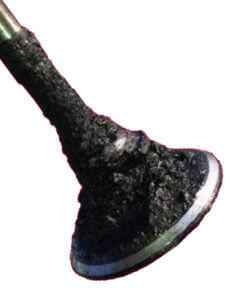Dual fuel injector technology takes off
Dual fuel injection technology
Gasoline direct injection was supposed to be the industry’s answer to demanding fuel economy mandates. The increased power derived by injecting fuel directly into the cylinder during the compression stroke allowed car makers to get more power from smaller engines and smaller engines meant less weight and MPH economies.
But problems began to appear with direct injection technology; carbon deposits on the valves, high soot levels and low speed pre-ignition that caused substantial engine damage.
Direct injection results in carbon buildup on the valves
In a port injected engine, the fuel is sprayed on the back of the intake

Buildup on the back face of an intake valve
valve, allowing fuel injection system cleaners to removed carbon accumulation. Once direct injection technology was employed, car makers and shops noticed in an increased in no start and poor running complaints caused by carbon buildup on the valves. The carbon build was due to oil mist being carried through the intake at engine running and shutdown. With the gasoline cleaners to wash off the carbon, it built up on the valves to the point where it prevented proper valve operation.
Why car makers shifted to direct injection
The addition of turbochargers allowed car makers to squeeze more power out of smaller engines. But the turbo charge in the early models caused detonation, which is why they required premium fuel. But direct injection reduced detonation issues because the evaporation of gasoline during the compression stroke cooled the air/fuel mixture, thereby eliminating detonation. So those engines can run on regular octane gas.
Duel injection solves the problems
Port fuel injection has some drawbacks; it’s not as efficient as direct injection and it simply doesn’t produce as much power. But port injection does provide better fuel vaporization and more torque under certain conditions. So car makers have begun designing engines with port and direct injection systems.
How duel fuel injection works
In 2017, Ford introduced duel injection on some 4, 6 and 8-cylinder engines. Here’s how the Ford duel injection system works:
Under heavy acceleration, the engine uses direct injection
During idle and decreased engine loads, the engine uses port injection.
The Toyota dual fuel D-4S injectors may both work at the same time. For example, during low to medium loads, the D-4S system uses both port and direct injection. But during high load conditions, the system switches to just the direct injectors so the technology can cool the combustion process.
Don’t confuse duel fuel injection with early “cold start” systems where a separate injector provided fuel only during cold starts. That’s not how the new systems work.
Fuel pumps on dual injection systems
Duel injection system still use a high pressure fuel pump and spill valve to deliver fuel to the direct injectors. Since some of these systems start the engine with port injection, the direct injectors must be held firmly in place to prevent compression from forcing them out.
Dual injection reduces need for air induction cleaning
Since dual injector systems wash the back of the intake valves, these engines don’t require air induction cleaning like direct injection only engines.
©, 2019 Rick Muscoplat
Posted on by Rick Muscoplat